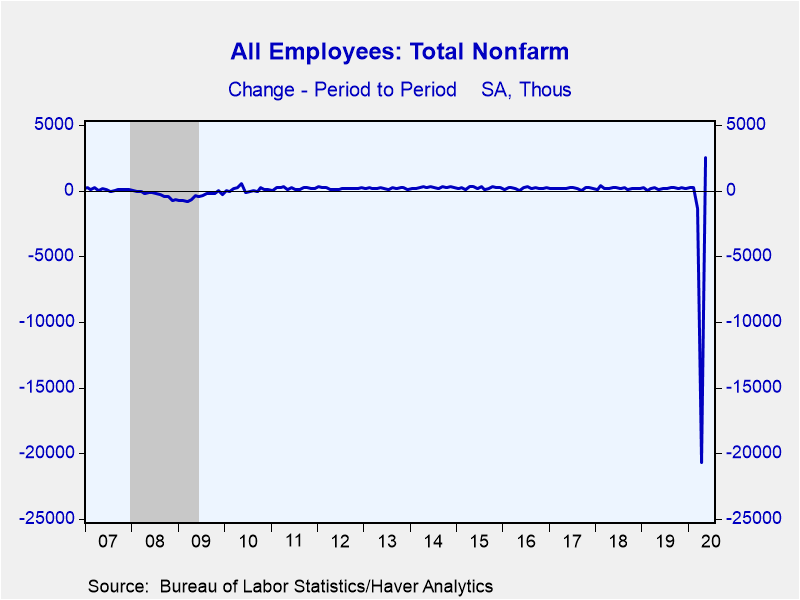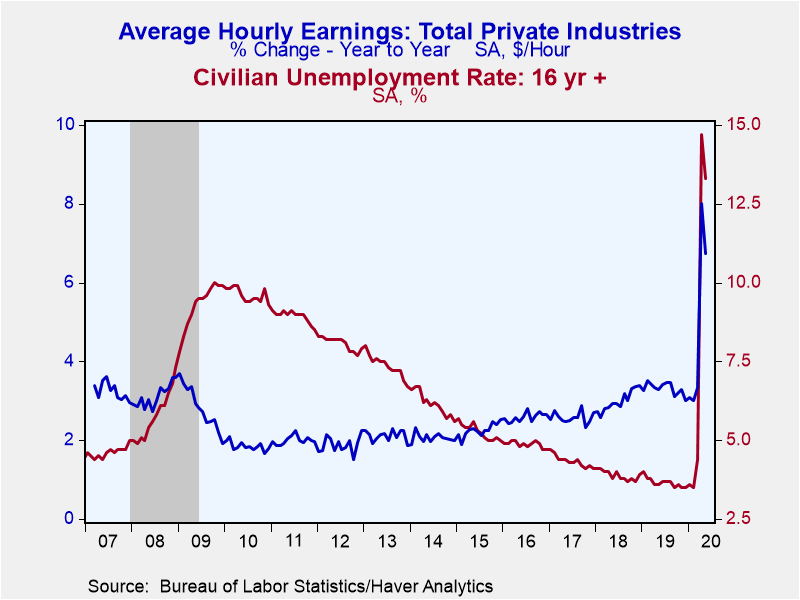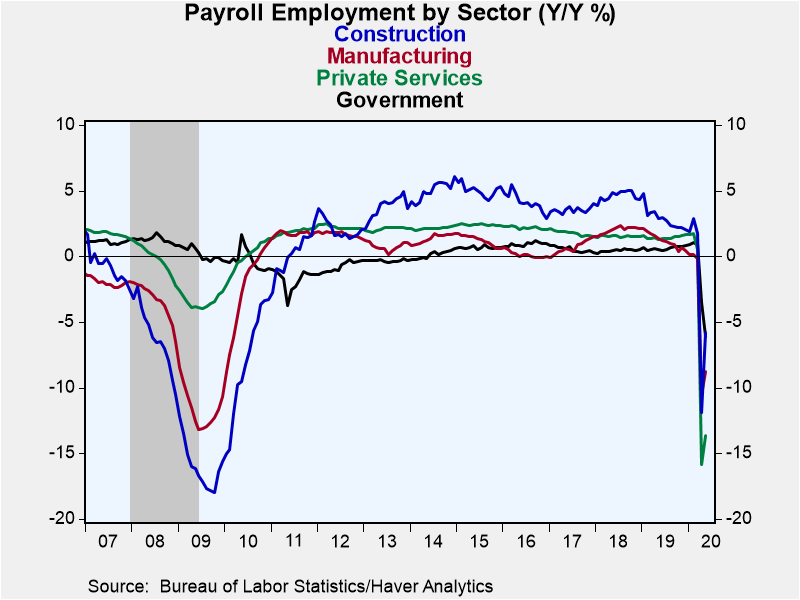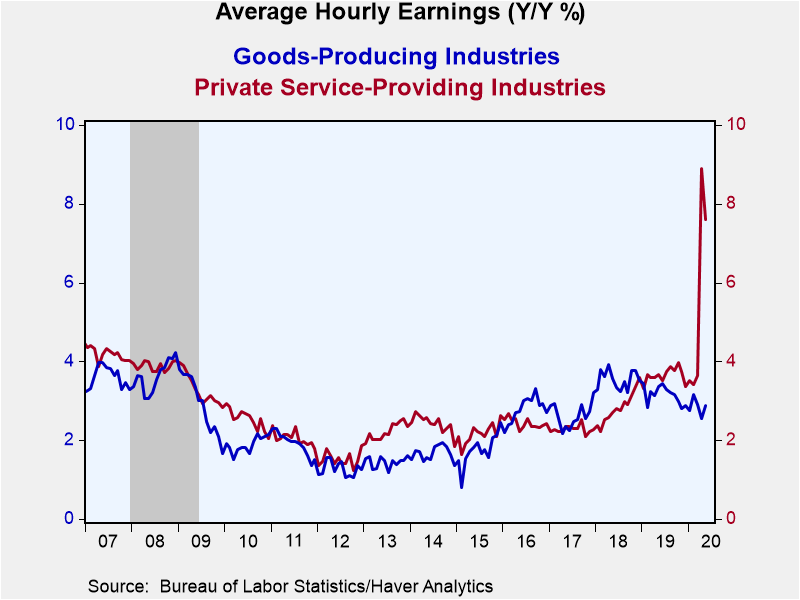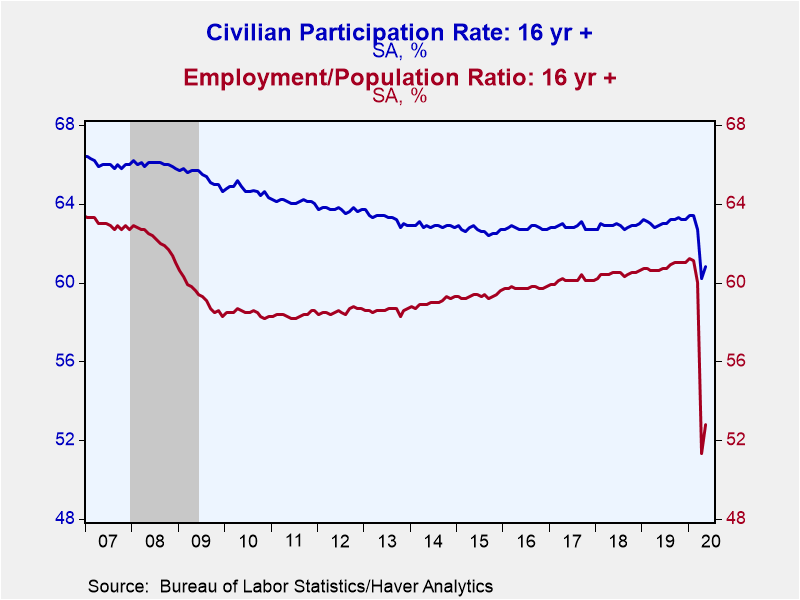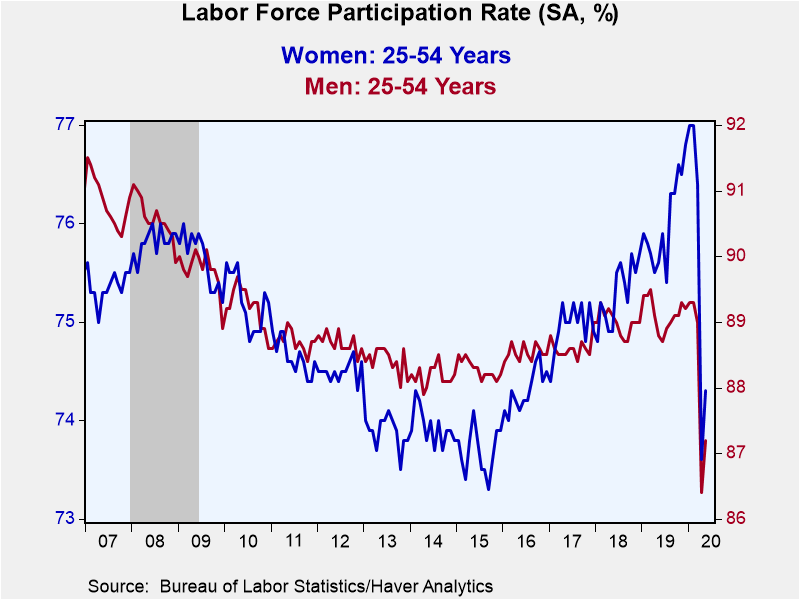 Global| Jun 05 2020
Global| Jun 05 2020U.S. Job Market Exhibits Modest Healing
by:Tom Moeller
|in:Economy in Brief
Summary
• Payroll hiring turns positive following declines induced by the coronavirus. • Jobless rate slips as employment increases. • Earnings falter after strong gains. The labor market showed signs of life in May following extreme duress [...]
• Payroll hiring turns positive following declines induced by the coronavirus.
• Jobless rate slips as employment increases.
• Earnings falter after strong gains.
The labor market showed signs of life in May following extreme duress in April. Nonfarm payroll employment improved 2.509 million last month after falling 20.687 million, revised from -20.500 million. The decline in March employment was increased to 1.373 million from 870,000 reported last month. An 8.165 million fall in May had been expected in the Action Economics Forecast Survey. Improvement was widespread amongst industries.
The unemployment rate fell to 13.3% and backed away from its postwar record of 14.7% in April. A rise to 19.8% had been expected. Employment in the household survey increased 3.839 million after falling 22.369 million while the labor force rose 1.746 million after declining 6.432 million. The overall jobless rate, including those who were marginally attached or working part-time for economic reasons, eased to 21.2% from 22.8%. Nevertheless, the unemployment rate remained close to a monthly high not seen since late-1940, according to the National Bureau of Economic Research.
The employment & earnings data are collected from surveys taken each month during the week containing the 12th of the month.
From the payroll employment survey, the 2.509 million in jobs reflected a 225,000 increase in factory sector employment which was the first gain in three months. Construction sector employment gained 464,000 and made up half of the prior month's decline. Employment in the mining & logging sector fell 20,000 (-14.6% y/y) after weakening 54,000.
The number of private service sector jobs rose 2.425 million, making up roughly one-tenth of the April decline. Modest increases following extreme declines were the rule amongst industries. Leisure & hospitality employment rose 1.239 million (-40.5% y/y) after declining 7.539 million. The education & health services job market improved 424,000 (-7.6% y/y) after a 2.590 million decline. Retail trade employment rose 367,800 (-12.2% y/y) following a 2.286 million shortfall and professional & business service sector jobs improved 127,000 (-8.7% y/y) after falling 2.189 million. Financial industry jobs increased 33,000 (-1.5% y/y) after declining 264,000. These gains were offset by weakness elsewhere in the private service sector. Continuing to drop was the number of information services jobs by 38,000 (-9.6% y/y), the third consecutive monthly fall.
In the government sector, there also was weakness in hiring. A 585,000 decline (-6.0% y/y) in the number of jobs was one of three straight monthly declines. The falloff was led by an extreme 487,000 drop (-7.8% y/y) in local government hiring which followed an even larger weakening in April. State government jobs declined 84,000 (-5.1% y/y) after dropping 167,000 and federal government hiring was off 14,000 (+1.6% y/y), the first month of decline this year.
Average hourly earnings in the private sector declined 1.0% (+6.7% y/y) following a 4.7% jump. A 1.1% gain had been expected.
Growth in average hourly earnings suffered from the hiring weakness with a 1.0% decline. The fall was led by a 3.1% decline (+5.3% y/y) in leisure & hospitality earnings which followed a 6.5% jump. Retail trade pay declined 1.0% (+6.8% y/y) following a 3.9% jump. Professional & business service sector earnings weakened 0.9% (+5.8% y/y) after rising 3.9%. To the upside, education & health care earnings rose 0.5% (3.6% y/y) after strengthening 1.3%. In the goods producing sector, factory sector earnings declined 1.1% (+5.0% y/y) after a 3.3% improvement and construction earnings improved 0.3% (2.5% y/y) following two months of 0.1% increase.
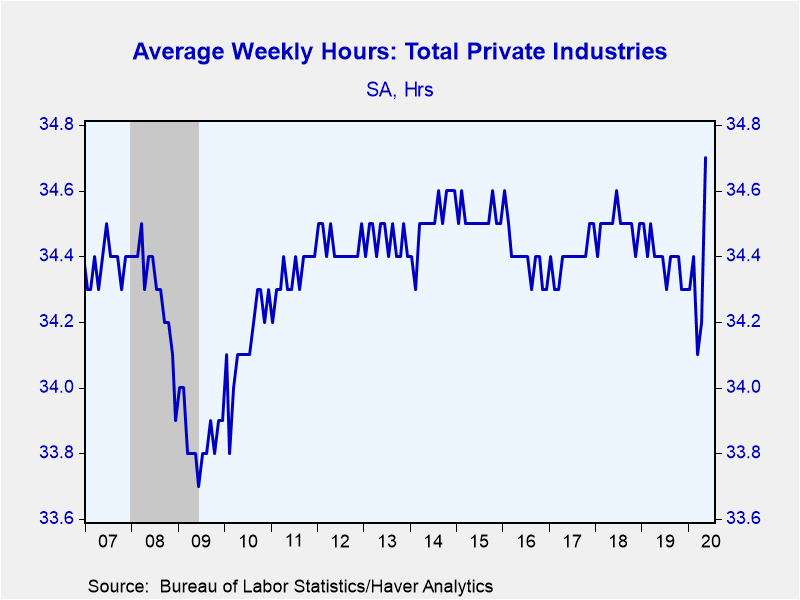 The length of the private sector workweek surged to a record 34.7 hours after
falling sharply to 34.2 in April. Private service sector hours increased to a
record 33.8 led by financial services to 37.8 hours and professional &
business services to 36.4 hours. Factory sector hours rose to 38.9 after falling
sharply to 38.1 in April from 40.4 in March. Construction sector hours rose to
38.9 after a decline to 37.9 in the prior month. Mining & logging sector
hours were steady at 43.0 after falling from 45.2 in March.
The length of the private sector workweek surged to a record 34.7 hours after
falling sharply to 34.2 in April. Private service sector hours increased to a
record 33.8 led by financial services to 37.8 hours and professional &
business services to 36.4 hours. Factory sector hours rose to 38.9 after falling
sharply to 38.1 in April from 40.4 in March. Construction sector hours rose to
38.9 after a decline to 37.9 in the prior month. Mining & logging sector
hours were steady at 43.0 after falling from 45.2 in March.
From the household survey, the decline in the unemployment rate to 13.3% occurred as the labor force participation rate improved to 60.8% after collapsing to 60.2% which was the lowest since January 1973. The teenage participation rate rose to 33.9% after falling to 30.8% in April, and for those aged 20-24, it nudged higher to 66.0% after plummeting to 64.5%. For workers aged 25-54, the rate recovered to 80.7%, after dropping sharply to 79.9% from 82.6%. For men in that age bracket, the rate rose to 87.2% after plunging to 86.4%. For women of that age, it inched up to 74.3%, up m/m to 73.6% which roughly equaled the annual cycle low of 73.7% during all of 2015. For workers aged 55 & over, the participation rate fell to 38.5%, a 13-year low. The employment/population ratio for all workers edged higher to 52.8% from 51.3%, but remained sharply lower than 61.2% in January.
The average duration of unemployment rose to 9.9 weeks in May after April's drop to 6.1 weeks, which contrasted with an annual high of 39.4 in 2012. The percentage of unemployed workers on temporary layoff fell to 73.0% from 78.3% in April. These figures were up from 12.6% at the start of the year.
The teenage unemployment rate eased to 29.9% from the record 31.9% in April, up from 14.3% in March. The rate for workers aged 20-24 also slipped from the record 25.7% to 23.2%, substantially higher than 8.7% in March. For workers aged 25-54, the rate slipped to 11.5% from the record 12.8%, more than triple its reading in March. For those over 55, the jobless rate eased to 11.8% from the record 13.6%, up from 3.3% in March.
By educational attainment, unemployment of workers without a high school diploma was 19.9% in May after spiking to 21.2% in April, following 6.8% in March. High school graduates without any college were 15.3% unemployed last month, down from 17.3% in April but still up from 4.4% in March. Those with some college but no degree were 13.3% without work in May, up from a near-record low of 2.7% in December. College graduates were 7.4% unemployed, increased from a 1.9% low in February.
The labor market data are contained in Haver's USECON database. Detailed figures are in the EMPL and LABOR databases. The expectations figures are in the AS1REPNA database.
Firms Expect Working from Home to Triple from the Federal Reserve Bank of Atlanta is available here.
| Employment: (SA, M/M Change, 000s) | May | Apr | Mar | May Y/Y | 2019 | 2018 | 2017 |
|---|---|---|---|---|---|---|---|
| Payroll Employment | 2,509 | -20,687 | -1,373 | -11.8% | 1.4% | 1.6% | 1.6% |
| Previous Estimate | -- | -20,500 | -870 | -- | -- | -- | -- |
| Manufacturing | 225 | -1,324 | -46 | -8.8 | 1.2 | 2.0 | 0.7 |
| Construction | 464 | -995 | -65 | -5.7 | 2.8 | 4.6 | 3.6 |
| Private Service-Producing | 2,425 | -27,351 | -1,237 | -13.7 | 1.4 | 1.5 | 1.8 |
| Government | -585 | -963 | -17 | -6.0 | 0.6 | 0.5 | 0.4 |
| Average Weekly Hours - Private Sector | 34.7 | 34.2 | 34.1 | 34.4 | 34.4 | 34.5 | 34.4 |
| Private Sector Average Hourly Earnings (%) | -1.0 | 4.7 | 0.6 | 6.7 | 3.3 | 3.0 | 2.6 |
| Unemployment Rate (%) | 13.3 | 14.7 | 4.4 | 3.6 | 3.7 | 3.9 | 4.3 |
Tom Moeller
AuthorMore in Author Profile »Prior to joining Haver Analytics in 2000, Mr. Moeller worked as the Economist at Chancellor Capital Management from 1985 to 1999. There, he developed comprehensive economic forecasts and interpreted economic data for equity and fixed income portfolio managers. Also at Chancellor, Mr. Moeller worked as an equity analyst and was responsible for researching and rating companies in the economically sensitive automobile and housing industries for investment in Chancellor’s equity portfolio. Prior to joining Chancellor, Mr. Moeller was an Economist at Citibank from 1979 to 1984. He also analyzed pricing behavior in the metals industry for the Council on Wage and Price Stability in Washington, D.C. In 1999, Mr. Moeller received the award for most accurate forecast from the Forecasters' Club of New York. From 1990 to 1992 he was President of the New York Association for Business Economists. Mr. Moeller earned an M.B.A. in Finance from Fordham University, where he graduated in 1987. He holds a Bachelor of Arts in Economics from George Washington University.


